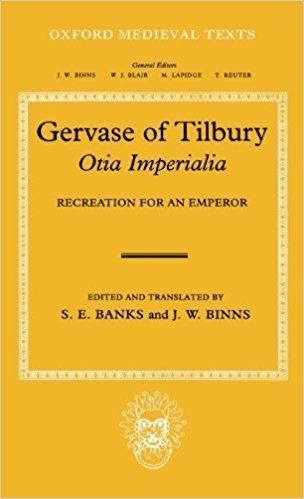 | ||
Similar Polycronycon, First voyage to America, Somnium Scipionis, Vita Merlini, Etymologiae | ||
Otia Imperialia ("Recreation for an Emperor") is an early 13th-century encyclopedic work, the best known work of Gervase of Tilbury. It is an example of Speculum literature. Also known as the "Book of Marvels", it primarily concerns the three fields of history, geography, and physics, but its credibility has been questioned by numerous scholars including philosopher Gottfried Leibniz, who was alerted to the fact that it contains many mythological stories. Its manner of writing is perhaps because the work was written to provide entertainment to Holy Roman Emperor Otto IV. However, many scholars consider it a very important work in that it "recognizes the correctness of the papal claims in the conflict between Church and Empire." It was written between 1210 and 1214, although some give the dates as between 1209 and 1214 and numerous authors state it was published c.1211.
Contents
Background
Though of English origin, Gervase was brought up in Rome. He travelled widely, took religious orders, studied and taught canon law at Bologna, was in Venice in 1177, at the reconciliation of Pope Alexander III and Frederick Barbarossa, and spent some time in the service of Henry II of England, and of his son, "Henry the Young King". For the latter, he composed a Liber facetiarum (‘Book of entertainment’), now lost, as well as the basis for what would become the Otia Imperialia.
Gervase settled in Arles and was appointed Marshal of the Kingdom of Arles in 1198 by Otto IV, Holy Roman Emperor, and grandson of King Henry. Ex officio he accompanied Otto to Rome in 1209 on the occasion of his coronation. The following year Gervase was enmeshed in the papacy's struggle with his patron Otto, who was excommunicated by Pope Innocent III. Gervase employed the next years, from 1210 to 1214, writing the Otia Imperialia for his patron. It was written at a time when other encyclopedic descriptions of the world were being produced and translated, such as the Summarium Heinrici, the Hortus deliciarum (Herrad of Landsberg), the Liber exceptionum (Richard de Saint-Victor, Jean Châtillon), the De proprietatibus rerum (Bartholomeus Anglicus), and the Speculum naturale (Vincent of Beauvais).
Content
Gervase's Otia imperialia has also been titled Liber de mirabilibus mundi, Solatia imperatoris, and Descriptio totius orbis. It is an encyclopedic miscellany of wonders in the manner of speculum literature, divided into three parts (decisiones) concerning history, geography, and physics. The text was accompanied by an illustration, "picturum, quam, mappam mundi vulgus nominat", the Ebstorf Map. Two books attributed to Gervase, De Mundi descriptione and De Mirabilibus Orbis, are actually parts of the Otia.
Along with the Imago Mundi (Honorius of Autun) and the Speculum naturale, the Otia contains fables attributed to Pliny the Elder and Solinus. The work contains many tales, mythological stories, and legends including the Powers of Virgil; the tale that a priest's cloak could be viewed as an element pitting good Christians against the Devil, and the legend of Osbert and the knight, associated with the Wandlebury Hill and fort near Cambridge, a site which he refers to as "Wandlebria". Of the Wandlebury legend he wrote as follows:
In England, on the borders of the diocese of Ely, there is a town called Cantabrica, just outside which is a place known as Wandlebria, from the fact that the Wandeli, when ravaging Britain and savagely putting to death the Christians, placed their camp there, Now, on the hill-top where they pitched their tents, is a level space ringed with entenchments with a single point of entry, like a gate. A very ancient legend exists, preserved in popular tradition, that if a warrior enters this level space at dead of night by moonlight and calls out 'Knight to knight, come forth', he will at once be faced by a warrior armed for fight, who charging horse against horse, will either dismount his adversary or himself be dismounted.
A knight named Osbert once tested the story and legend has it that he appeared in full armour and defeated the knight who appeared to him but was wounded in the thigh by his opponents' javelin on departing."
Reception
During the following three centuries, it was much read, and it was twice translated into French in the fourteenth century. The Gottfried Leibniz, who edited parts of it, called it a "bagful of foolish old woman's tales", while its modern Oxford University Press editors less dismissively report "a wealth of accounts of folklore and popular belief". Catholic apologists respect it most of all for the support it offers of Innocent's papal claims in his conflicts between Church and Empire. Portions of it were printed in Historiie Francorum Scriptores (André Duchesne, 1641), and by J. J. Mader (1673). Large portions were published in Scriptores Rerum Brunsvicensium (G. G. Leibnitz, 1707–10). The third part of Otia was edited by Felix Liebrecht and published by Carl Rümpler (1856).
